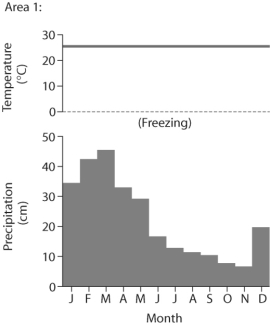Course
Biology Science
Study Pack
Set 49 An Introduction To Ecology
Question 1
(Multiple Choice)
Free
Which of the following terms does NOT describe how much all of the plants in a biome grow?
A) productivity
B) aboveground biomass
C) photosynthetic quotient
D) net primary productivity
Answer
Question 2
(Multiple Choice)
Free

 Figure 49.2
Figure 49.2-Based on the data in Figure 49.2, which of the following statements is FALSE?
A) Area 2 would be considered a desert because of its low average precipitation.
B) Area 2 has a large annual temperature variation.
C) Area 1 has more average precipitation than area 2.
D) Area 1 would be considered a desert because of its high average temperature.
Answer
Question 3
(Multiple Choice)
Free
A certain species of pine tree survives only in scattered locations at elevations above 2800 metres in the western United States. To understand why this tree grows only in these specific places, an ecologist should
A) investigate the various biotic and abiotic factors that are unique to high altitude.
B) collect data on temperature, wind, and precipitation at several of these locations for a year.
C) conclude that lower elevations are limiting to the survival of this species.
D) analyze the soils found in the vicinity of these trees, looking for unique chemicals that may support their growth.
E) study the anatomy and physiology of this species.
Answer